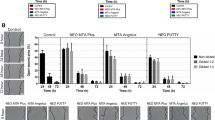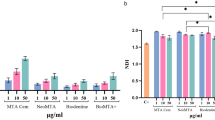Abstract
Purpose
This study aimed to evaluate the cytotoxic effects of different types of contemporary GICs on human dental pulp cell (hDPCs) and mouse fibroblast (L929) cultures.
Methods
Three high-viscosity GICs (HVGIC; GC Equia Forte, Riva Self Cure, IonoStar Plus), three resin-modified GICs (RMGIC; Photac Fil, Riva Light Cure, Ionolux), and a metal-reinforced GIC (MRGIC; Riva Silver) were investigated. Twelve disc-shaped specimens of each material were prepared and stored in Dulbecco’s modified Eagle medium (DMEM). L929 fibroblasts and DPCs were then cultured in 96-well plates. Uncultured DMEM was used as a negative control. Mitochondrial dehydrogenase activity (MTT) assays were performed to detect cell viability after 24, 48, and 72 h. Data were analysed using Mann–Whitney U and Friedman tests followed by a Bonferroni-corrected Wilcoxon signed rank test, with the statistical significance set at P < 0.05.
Results
Toxicity levels varied between the cell-culture systems. MTT assays of L929 cells showed significant differences in percentages of viable cells, as follows: Riva Self Cure = Riva Silver > GC Equia Forte > IonoStar Plus = Riva Light Cure = Photac Fil > Ionolux. MTT assays of DPCs showed the percentages of viable cells to be significantly lower for the Ionolux group when compared to the other GICs, which did not differ significantly from one another. With the exception of Ionolux, none of the other GICs tested showed any toxicity, and in fact, they all induced cell proliferation (> 100% cell viability).
Conclusions
Although the degree of toxicity varied between the two cell-culture systems investigated, all the GICs tested, with the exception of Ionolux, performed favorably with regard to cytotoxicity (> 100% cell viability in both cell systems).

Similar content being viewed by others
References
Ahmed HM, Omar NS, Luddin N, Saini R, Saini D. Cytotoxicity evaluation of a new fast set highly viscous conventional glass ionomer cement with L929 fibroblast cell line. J Conserv Dent. 2011;14:406–8.
Aranha AMF, Giro EMA, Souza PPC, Hebling J, de Souza Costa CA. Effect of curing regime on the cytotoxicity of resin-modified glass-ionomer lining cements applied to an odontoblast-cell line. Dent Mater. 2006;22:864–9.
Arndt V. Completing a direct posterior restoration using Ionofil Molar AC Quick immediately packable glass ionomer. In: Dental Product Report. 2002. http://www.highbeam.com/doc/1P3-260753781.html. Accessed Dec 2002.
Chang HH, Guo MK, Kasten FH, et al. Stimulation of glutathione depletion ROS production and cell cycle arrest of dental pulp cells and gingival epithelial cells by HEMA. Biomaterials. 2005;26:745–53.
Costa CA, Vaerten MA, Edwards CA, Hanks CT. Cytotoxic effects of current dental adhesive systems on immortalized odontoblast cell line MDPC-23. Dent Mater. 1999;15:434–41.
Costa CA, Hebling J, Hanks CT. Current status of pulp therapy with dentin adhesive systems. A review. Dent Mater. 2000;16:188–97.
Costa CAS, Giro EM, do Nascimento AB, Teixeira HM, Hebling J. Short-term evaluation of the pulp-dentin complex response to a resin-modified glass-ionomer cement and a bonding agent applied in deep cavities. Dent Mater. 2003;19:739–46.
Davidson CL. Advances in glass-ionomer cements. J Appl Oral Sci. 2006;14:3–9.
De Souza Costa CA, Hebling J, Garcia-Godoy F, Hanks CT. In vitro cytotoxicity of five glass-ionomer cements. Biomaterials. 2003;24:3853–8.
Gaintantzopoulou MD, Willis GP, Kafrawy AH. Pulp reactions to light-cured glass ionomer cements. Am J Dent. 1994;7:39–42.
Gao W, Smales RJ. Fluoride release/uptake of conventional and resin-modified glass ionomer cement and compomer. J Dent. 2001;29:301–6.
Geurtsen W, Lehmann F, Spahl W, Leyhausen G. Cytotoxicity of 35 dental resin composite monomers/additives in permanent 3T3 and three human primary fibroblast cultures. J Biomed Mater Res. 1998;41:474–80.
Geursten W. Biocompatibility of resin-modified filling materials. Crit Rev Oral Biol Med. 2000;11:333–55.
Hanks CT, Anderson M, Craig RG. Cytotoxic effects of dental cements on two cell culture systems. J Oral Pathol. 1981;10:101–12.
Hensten-Pettersen A, Helgeland K. Sensitivity of different human cell line in the biologic evaluation of dental resin-based restorative materials. Scand J Dent Res. 1981;89:102–7.
Hotz P, McLean JW, Sced I, Wilson AD. The bonding of glass-ionomer cements to metal and tooth substrates. Br Dent J. 1977;142:41–7.
Huang FM, Chang YC. Cytotoxicity of resin-based restorative materials on human pulp cell cultures. Oral Surg Oral Med Oral Pathol Oral Radiol Endod. 2002;94:361–5.
Kılıç Süloğlu A, Selmanoğlu G, Yılmaz Ş, Canpınar H. Comparison of phototoxic effects of hypericin-mediated photodynamic therapy in HT-29 and Caco-2 colon cancer cells. Turk J Biol. 2016;40:1202–18.
Lan WH, Lan WC, Wang TM, et al. Cytotoxicity of conventional and modified glass ionomer cements. Oper Dent. 2003;28:251–9.
Li F, Weir MD, Chen J, Xu HH. Comparison of quaternary ammonium-containing with nano-silver-containing adhesive in antibacterial properties and cytotoxicity. Dent Mater. 2013;29:450–61.
Lutfi AN, Kannan TP, Fazliah MN, Jamaruddin MA, Saidi J. Proliferative activity of cells from remaining dental pulp in response to treatment with dental materials. Aust Dent J. 2010;55:79–85.
Marczuk-Kolada G, Luczaj-Cepowicz E, Pawinska M, Holownia A. Evaluation of the cytotoxicity of selected conventional glass ionomer cements on human gingival fibroblasts. Adv Clin Exp Med. 2017;26:1041–5.
Mickenautsch S, Mount G, Yengopal V. Therapeutic effect of glass ionomers: an overview of evidence. Austr Dent J. 2011;56:10–5.
Moharamzadeh K, Van Noort R, Brook IM, Scutt AM. Cytotoxicity of resin monomers on human gingival fibroblasts and HaCaT keratinocytes. Dent Mater. 2007;23:40–4.
Mount GJ. Clinical performance of glass-ionomers. Biomaterials. 1998;19:573–9.
Mozayeni MA, Milani AS, Marvasti LA, Asgary S. Cytotoxicity of calcium enriched mixture cement compared with mineral trioxide aggregate and intermediate restorative material. Aust Endod J. 2012;38:70–5.
Murray PE, Garcia Godoy C, Garcia Godoy F. How is the biocompatibility of dental biomaterials evaluated? Med Oral Patol Oral Cir Bucal. 2007;12:E258–66.
Nicholson JW, Czarnecka B. The biocompability of resin-modified glass ionomer cements for dentistry. Dent Mater. 2008;24:1702–8.
Palmer G, Anstice HM, Pearson GJ. The effect of curing regime on the release of hydroxyethyl methacrylate (HEMA) from resin-modified glass ionomer cements. J Dent. 1999;27:303–11.
Park MV, Neigh AM, Vermeulen JP, et al. The effect of particle size on the cytotoxicity, inflammation, developmental toxicity and genotoxicity of silver nano-particles. Biomaterials. 2011;32:9810–7.
Rimondini L, Mele S. Stem cell technologies for tissue regeneration in dentistry. Minerva Stomatol. 2009;58:483–500.
Schmalz G. Concepts in biocompatibility testing of dental restorative materials. Clin Oral Invest. 1997;1:154–62.
Schmid-Schwap M, Franz A, König F, et al. Cytotoxicity of four categories of dental cements. Dent Mater. 2009;25:360–8.
Sidhu SK. Glass-ionomer cement restorative materials: a sticky subject? Aust Dent J. 2011;56:23–30.
Stanislawski L, Daniau X, Lauti A, Goldberg M. Factors responsible for pulp cell cytotoxicity induced by resin-modified glass-ionomer cements. J Biomed Mater Res. 1999;48:277–88.
Taira M, Nakao H, Matsumoto T, Takahashi J. Cytotoxic effect of methyl methacrylate on 4 cultured fibroblasts. Int J Prosthodont. 2000;13:311–5.
Tarim B, Hafez AA, Cox CF. Pulpal response to a resin-modified glass-ionomer material on nonexposed and exposed monkey pulps. Quint Int. 1998;29:535–42.
Xie D, Brantley BM, Culbertson G, Wang G. Mechanical properties and microstructures of glass-ionomer cements. Dent Mater. 2000;16:129–38.
van Duinen RN, Kleverlaan CJ, de Gee AJ, Werner A, Feilzer AJ. Early and long-term wear of “fast-set” conventional glass-ionomer cements. Dent Mater. 2005;21:716–20.
Vega-Avila E, Pugsley MK. An overview of colorimetric assay methods used to assess survival or proliferation of mammalian cells. Proc West Pharmacol Soc. 2011;54:10–4.
Volarevic V, Al-Qahtani A, Arsenijevic N, Pajovic S, Lukic ML. Interleukin-1 receptor antagonist (IL-1Ra) and IL-1Ra producing mesenchymal stem cells as modulators of diabetogenesis. Autoimmunity. 2010;43:255–63.
Yap AU, Pek YS, Cheang P. Physico-mechanical properties of a fast-set highly viscous GIC restorative. J Oral Rehabil. 2003;30:1–8.
Zhang K, Cheng L, Imazato S, et al. Effects of dual antibacterial agents MDPB and nano-silver in primer on microcosm biofilm, cytotoxicity and dentine bond properties. J Dent. 2013;41:464–74.
Author information
Authors and Affiliations
Corresponding author
Ethics declarations
Conflict of interest
The authors affirm that they do not presently have, nor have they had in the past, any direct financial interest in the subject or materials discussed in this manuscript, or any affiliation with any commercial organisation with any such financial interest.
Additional information
Publisher's Note
Springer Nature remains neutral with regard to jurisdictional claims in published maps and institutional affiliations.
Rights and permissions
About this article
Cite this article
Ersahan, S., Oktay, E.A., Sabuncuoglu, F.A. et al. Evaluation of the cytotoxicity of contemporary glass-ionomer cements on mouse fibroblasts and human dental pulp cells. Eur Arch Paediatr Dent 21, 321–328 (2020). https://doi.org/10.1007/s40368-019-00481-1
Received:
Accepted:
Published:
Issue Date:
DOI: https://doi.org/10.1007/s40368-019-00481-1




